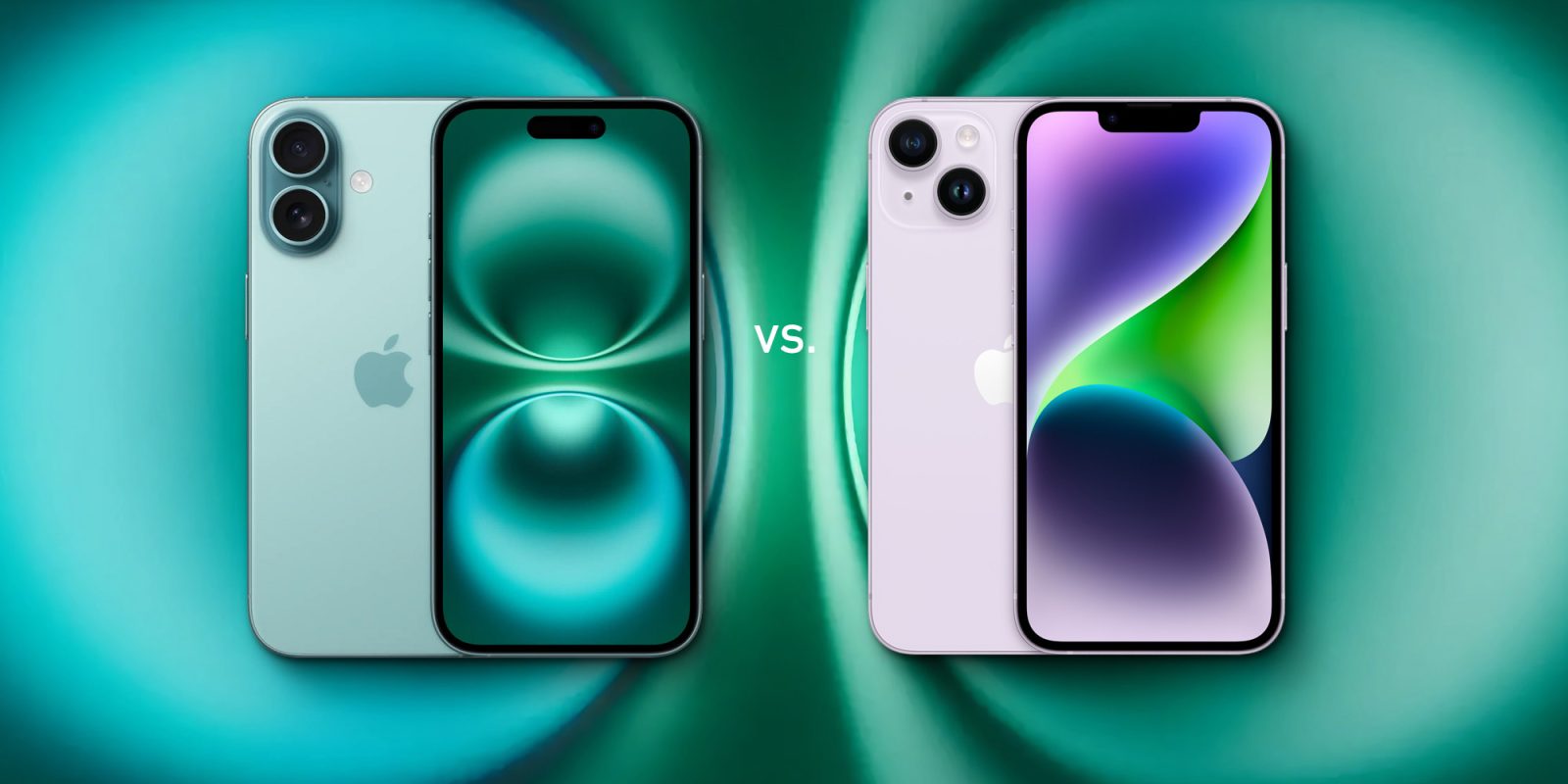
iPhone 16 is Apple’s newest and most capable non-pro smartphone. Yet the device has gained pro features this year, separating itself from its predecessors more than usual. Read on for a detailed look at iPhone 16 vs 14 for everything new and advice on whether it’s worth upgrading.
Table of contents
For other detailed comparisons of the standard vs pro models and more, check out these guides, otherwise read on below.
iPhone 16 vs 14
Screens
While the iPhone 16 Pro models feature larger 6.3 and 6.9-inch displays, the iPhone 16 and 16 Plus have 6.1 and 6.7-inch screens, just like the iPhone 14 and 14 Plus.
Resolution, PPI, and other display features remain nearly identical between iPhone 16/Plus and iPhone 14/Plus.
But you do get brighter screens, the Dynamic Island, and a slight increase in pixels with the latest iPhones.
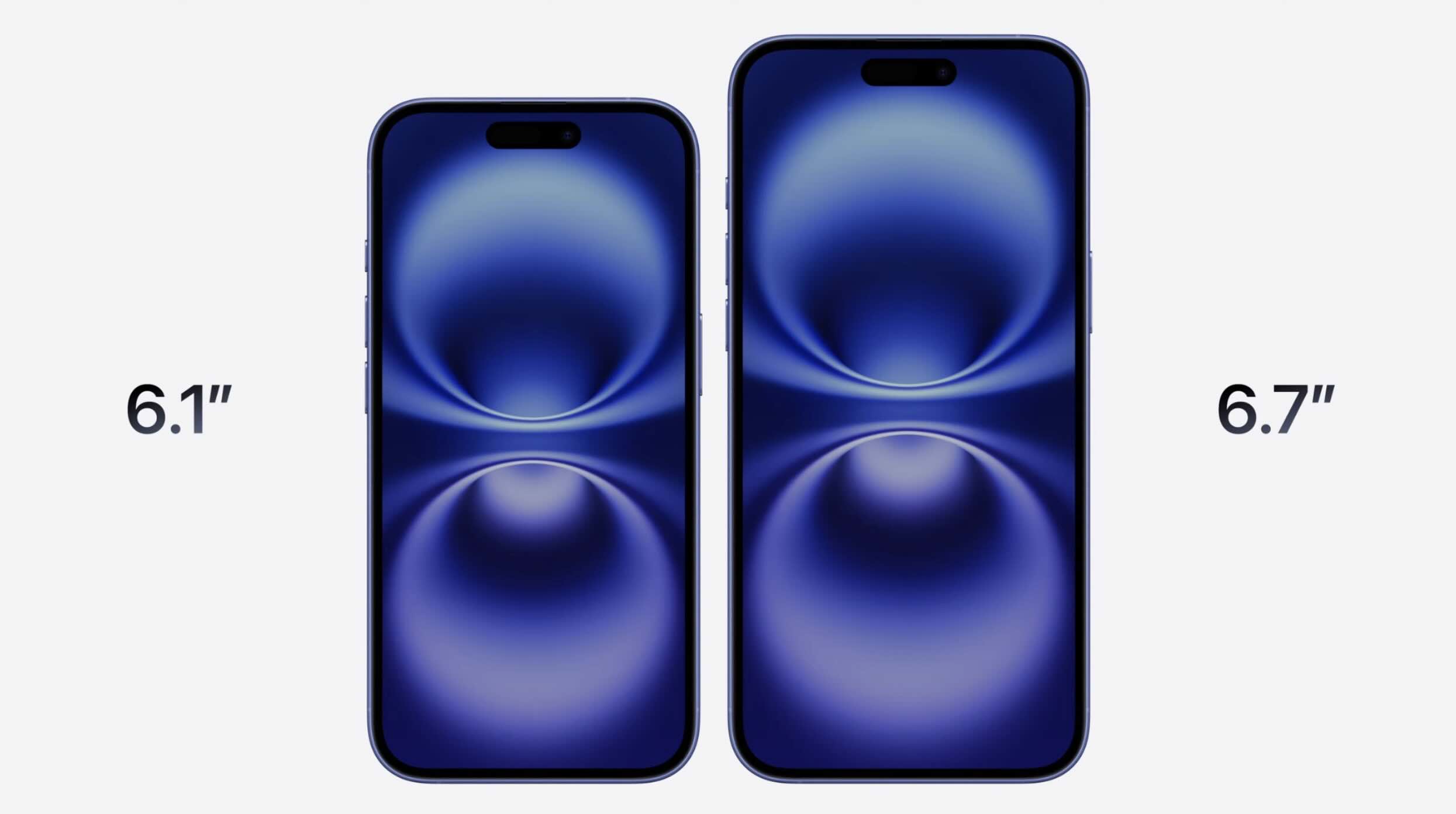
| iPhone 16 | iPhone 14 | iPhone 16 Plus | iPhone 14 Plus | |
| Size | 6.1-inches | 6.1-inches | 6.7-inches | 6.7-inches |
| Resolution | 2556 x 1179 pixels | 2532 x 1170 pixels | 2796 x 1290 pixels | 2778 x 1284 pixels |
| PPI | 460 ppi | 460 ppi | 460 ppi | 458 ppi |
| Super Retina XDR OLED display | ✅ | ✅ | ✅ | ✅ |
| Dynamic Island | ✅ | ❌ | ✅ | ❌ |
| ProMotion – adaptive refresh up to 120Hz | ❌ | ❌ | ❌ | ❌ |
| Always-On display | ❌ | ❌ | ❌ | ❌ |
| Typical max brightness | 1000 nits max | 800 nits max | 1000 nits max | 800 nits max |
| HDR max brightness | 1600 nits max | 1200 nits max | 1600 nits max | 1200 nits max |
| Outdoor max brightness | 2000 nits max | – | 2000 nits max | – |
| True Tone | ✅ | ✅ | ✅ | ✅ |
| Haptic Touch | ✅ | ✅ | ✅ | ✅ |
| Wide color (P3) | ✅ | ✅ | ✅ | ✅ |
Size, weight, design
The iPhone 16 and 16 Plus design remains almost identical to its predecessor(s), but Apple has included the new physical Camera Control button/sensor.
iPhone 16 also gets the physical Action button which was originally launched on iPhone 15 Pro. And the rear camera layout has been updated with the 16 and 16 Plus.
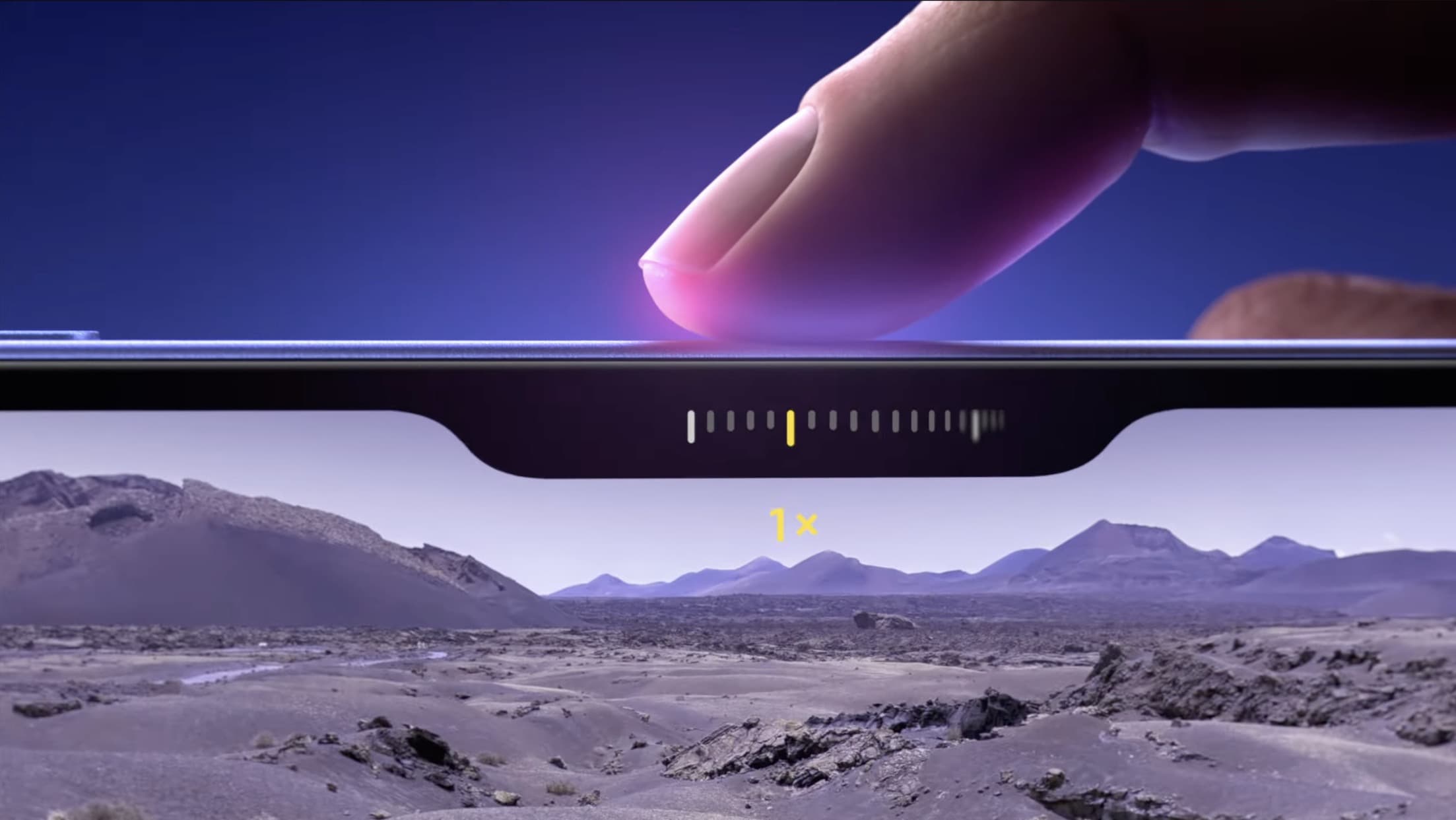
iPhone 16 and 16 Plus are a touch lighter in weight compared to their predecessors with roughly the same footprints.
| iPhone 16 | iPhone 14 | iPhone 16 Plus | iPhone 14 Plus | |
| Height | 5.81-inches (147.6 mm) | 5.78-inches (146.7 mm) | 6.33-inches (160.9 mm) | 6.33-inches (160.8 mm) |
| Width | 2.82-inches (71.6 mm) | 2.82-inches (71.5 mm) | 3.06-inches (77.8 mm) | 3.07-inches (78.1 mm) |
| Thickness | 0.31-inches (7.80 mm) | 0.31-inches (7.80 mm) | 0.31-inches (7.80 mm) | 0.31-inches (7.80 mm) |
| Weight | 6.00-ounces (170 grams) | 6.07-ounces (172 grams) | 7.03-ounces (199 grams) | 7.16-ounces (203 grams) |
| Durability | IP68 (splash, dust, 6 meters of water up to 30 minutes | IP68 (splash, dust, 6 meters of water up to 30 minutes | IP68 (splash, dust, 6 meters of water up to 30 minutes | IP68 (splash, dust, 6 meters of water up to 30 minutes |
| Ceramic Shield front | ✅ | ✅ | ✅ | ✅ |
| Back material | Color-infused glass | Colored glass | Color-infused glass | Colored glass |
| Frame/edges | Aluminum | Aluminum | Aluminum | Aluminum |
Naturally, the new iPhones also come in new colors, we’ll cover that below.
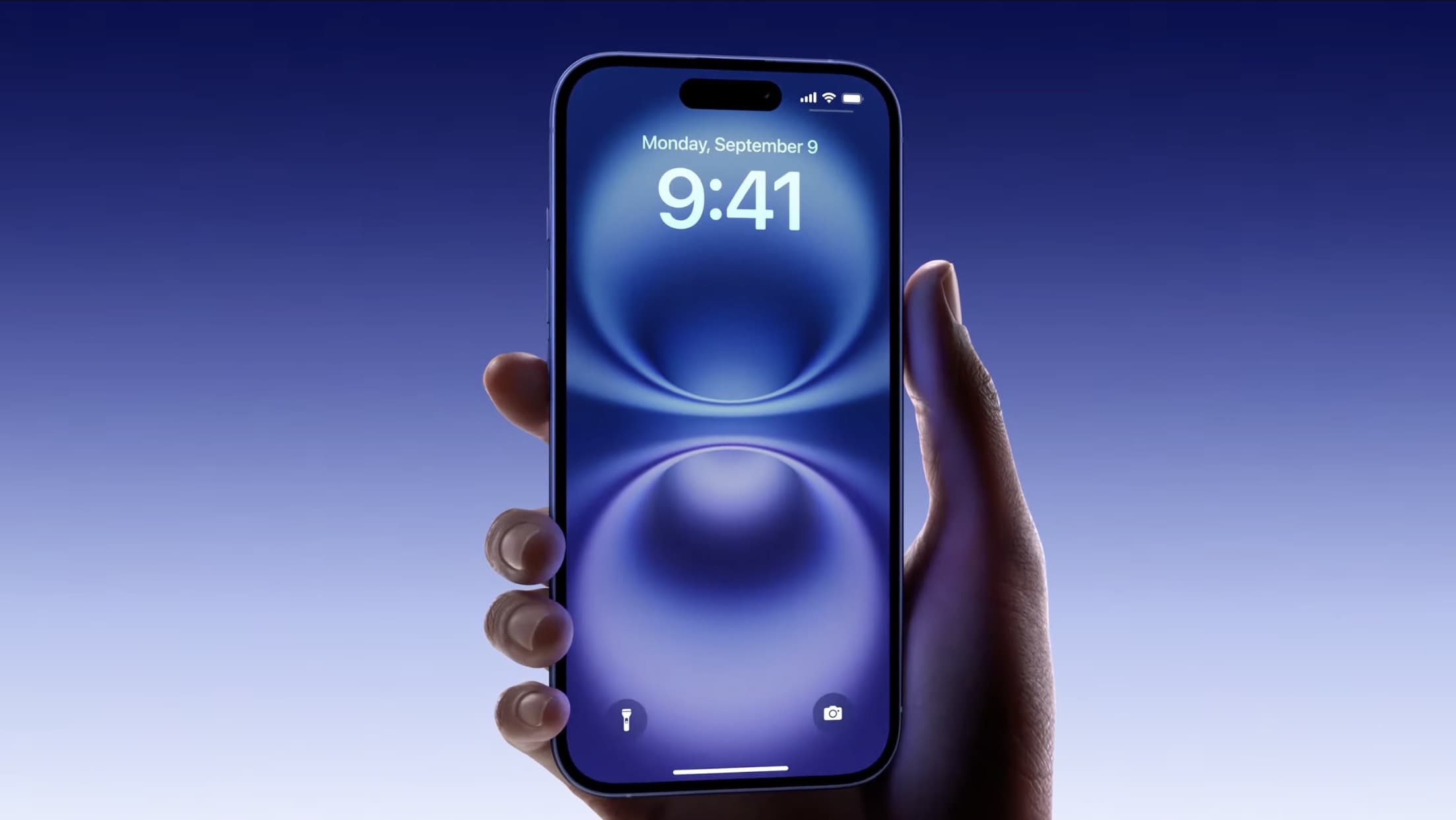
Performance – A18 vs A15
With iPhone 14 and 15, Apple used the latest A-series chip in the Pro models and the previous year’s chip in the standard models.
That changes this year with the iPhone 16 and 16 Plus getting the new A18 chip – a 3-gen jump from the A15 Bionic in iPhone 14/Plus.
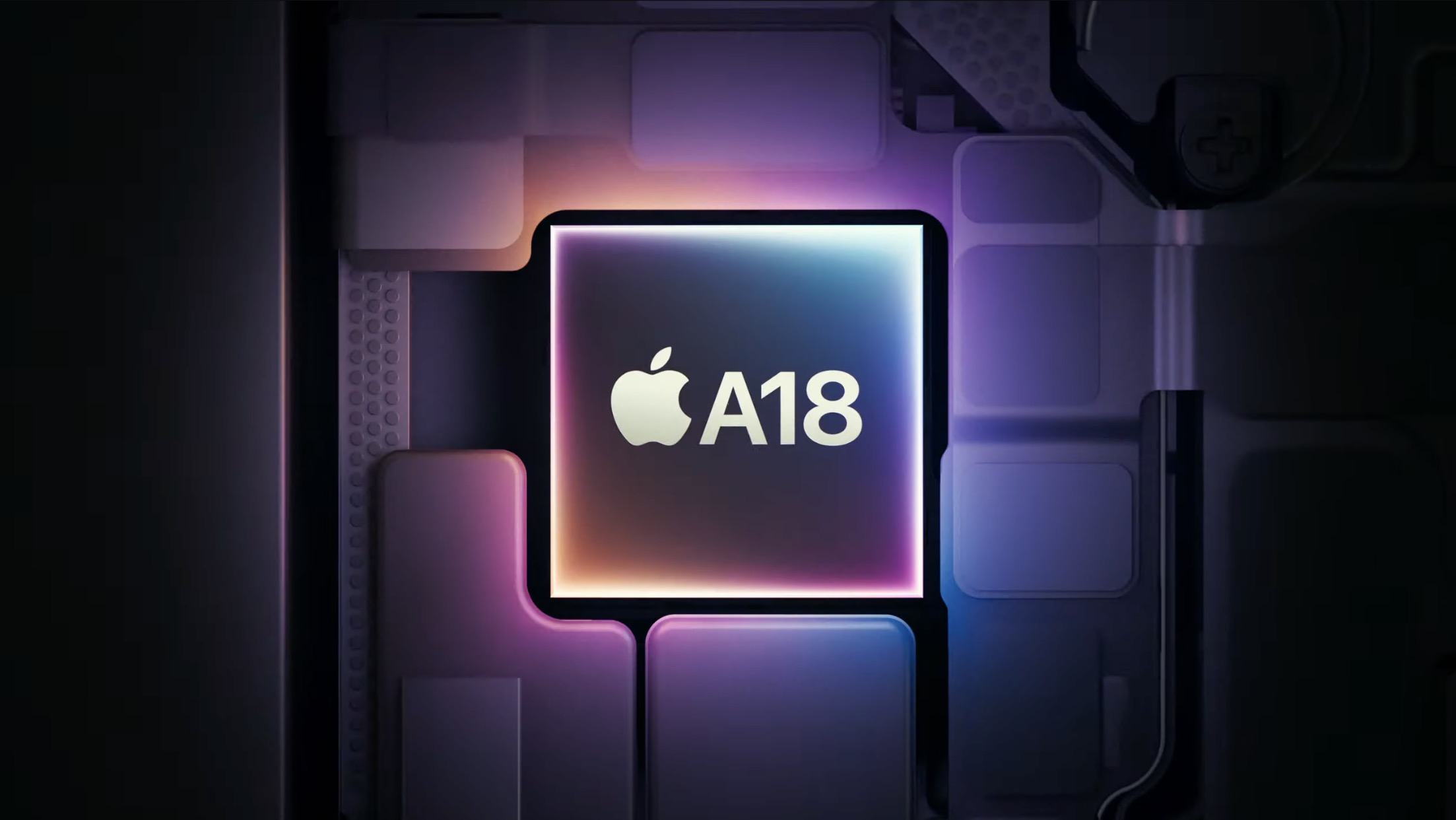
With the only previous iPhones to support Apple Intelligence being the 15 Pro and Pro Max, iPhone 16 and 16 Plus get Apple Intelligence while the iPhone 14 and 14 Plus do not.
| iPhone 16 | iPhone 14 | iPhone 16 Plus | iPhone 14 Plus | |
| SoC | A18 | A15 Bionic | A18 | A15 Bionic |
| CPU | 6-core: 2 performance + 4 efficiency | 6-core: 2 performance + 4 efficiency | 6-core: 2 performance + 4 efficiency | 6-core: 2 performance + 4 efficiency |
| GPU | 5-core | 5-core | 5-core | 5-core |
| Neural Engine | 16-core | 16-core | 16-core | 16-core |
| RAM | 8GB | 6GB | 8GB | 6GB |
| Apple Intelligence support | ✅ | ❌ | ✅ | ❌ |
Both the A18 and A15 are plenty powerful enough for almost everyone. But Apple highlights that the A18 CPU is up to 50% faster than A15 Bionic.
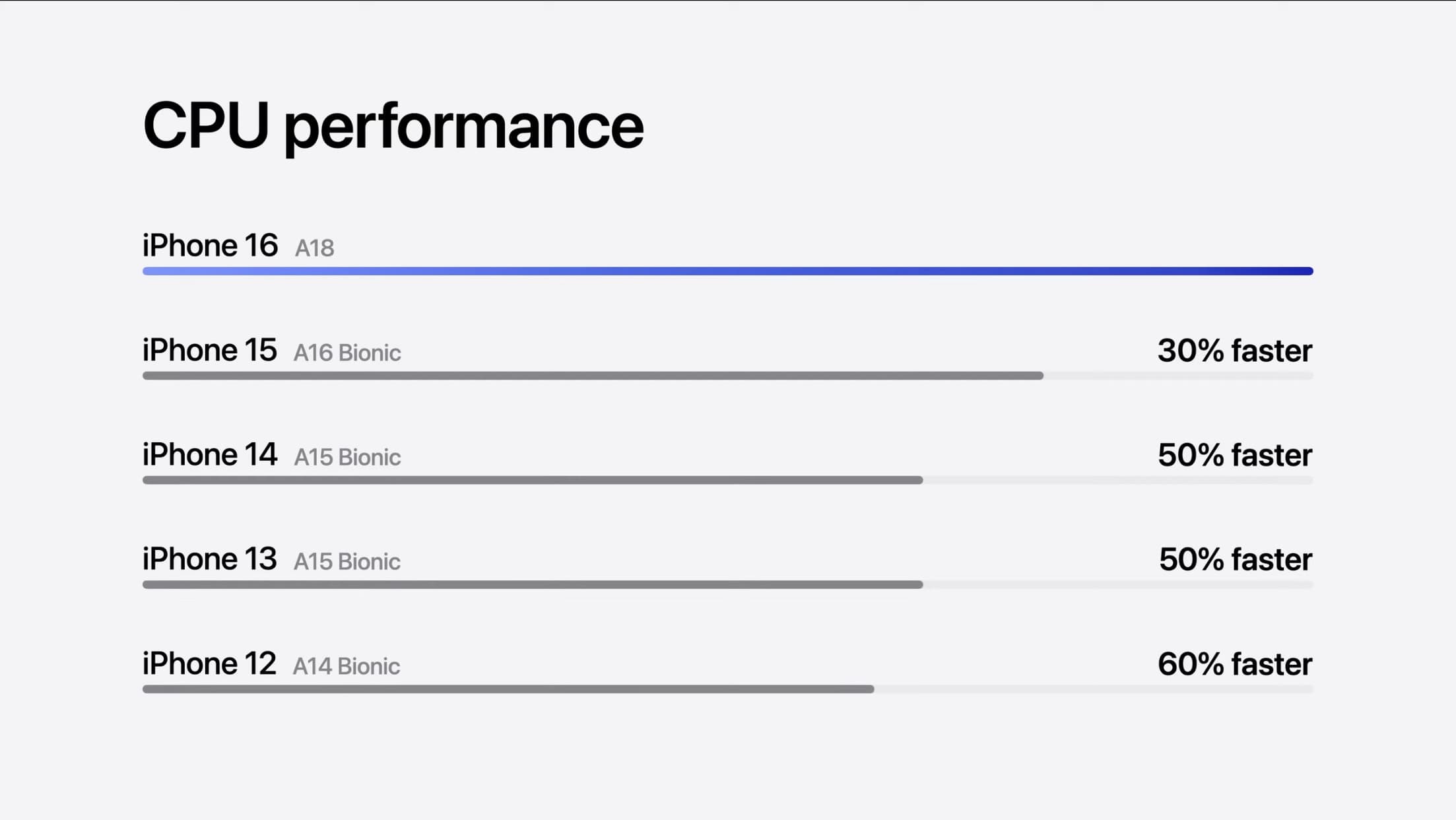
Also, A18 is the first chip in a non-pro iPhone to offer hardware-accelerated ray tracing. That will deliver improved gaming on iPhone 16 and 16 Plus.
Battery life

For battery life, the iPhone 16 has received a very slight improvement over the iPhone 14 devices for video playback:
| iPhone 16 | iPhone 14 | iPhone 16 Plus | iPhone 14 Plus | |
| Video playback | 22 hours | 20 hours | 27 hours | 26 hours |
| Audio playback | 80 hours | 80 hours | 100 hours | 100 hours |
For how that compares to iPhone 15, 14, and 13, check out our full post on iPhone 16 battery life:
iPhone 16 vs 14 cameras
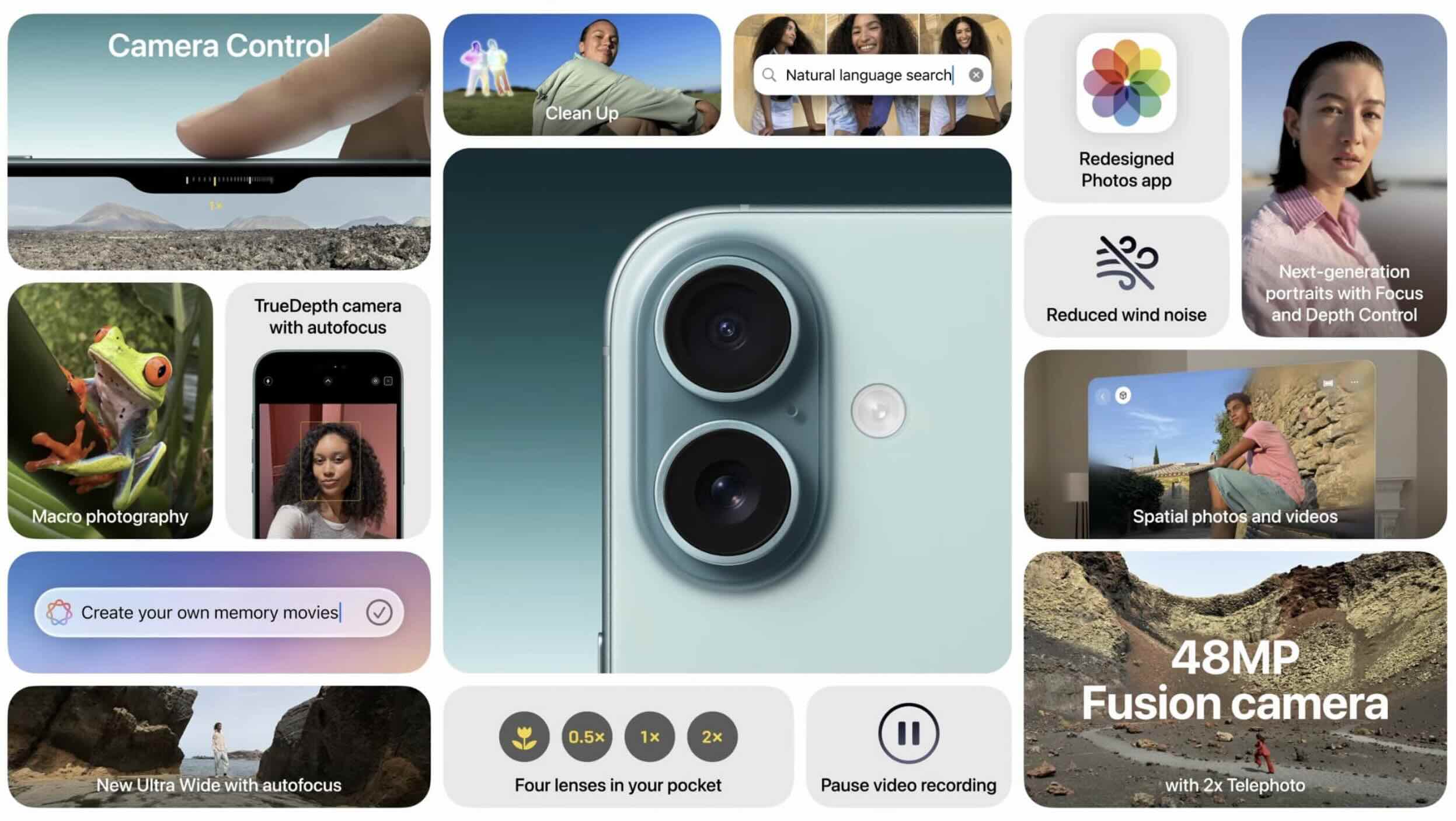
Rear cameras
iPhone 16/Plus come with a 48MP main rear camera like iPhone 15/Plus. That’s a notable upgrade over the iPhone 14 with a 12MP main lens.
More new additions include the all-new Camera Control button/sensor, latest-gen Photographic Styles, and the ability to capture spatial photos and video.
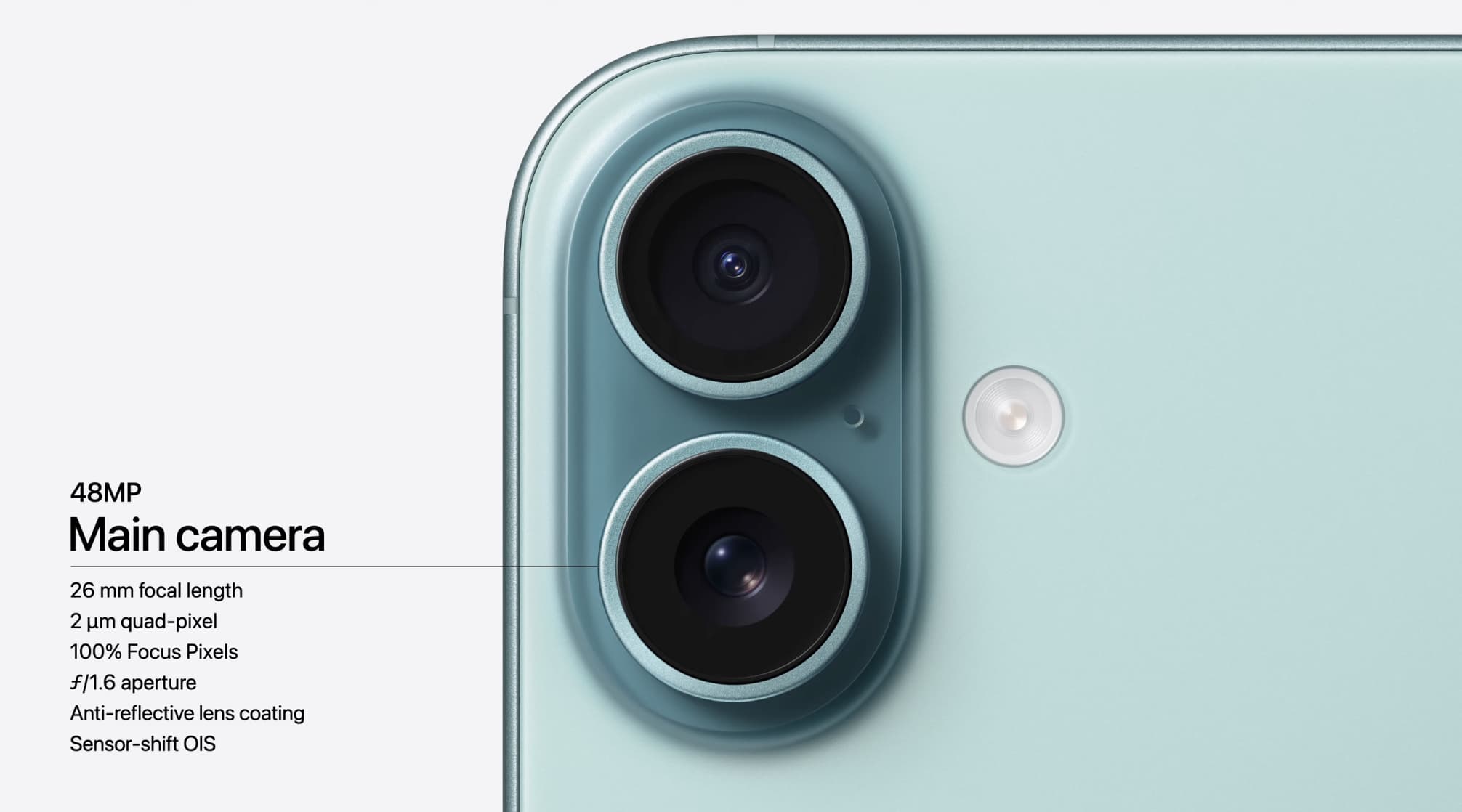
| iPhone 16 | iPhone 14 | iPhone 16 Plus | iPhone 14 Plus | |
| Camera Control | ✅ | ❌ | ✅ | ❌ |
| Main lens | 48MP, ƒ/1.6 aperture | 12MP, ƒ/1.5 aperture | 48MP, ƒ/1.6 aperture | 12MP, ƒ/1.5 aperture |
| Main lens sensor | 2 µm quad pixel | 1.9 µm quad pixel | 2 µm quad pixel | 1.9 µm quad pixel |
| Main lens focal length | 26 mm | 26 mm | 26 mm | 26 mm |
| Ultra Wide lens | 12MP, ƒ/2.2 aperture | 12MP, ƒ/2.4 aperture | 12MP, ƒ/2.2 aperture | 12MP, ƒ/2.4 aperture |
| Telephoto lens | ❌ (but main lens can do 2x zoom) | ❌ | ❌ (but main lens can do 2x zoom) | ❌ |
| Stabilization | Sensor-shift optical image stabilization | Sensor-shift optical image stabilization | Sensor-shift optical image stabilization | Sensor-shift optical image stabilization |
| Optical zoom | 0.5x, 1x, and 2x | 0.5x and 1x | 0.5x, 1x, and 2x | 0.5x and 1x |
| Digital zoom | Up to 10x | Up to 5x | Up to 10x | Up to 5x |
| Flash | True Tone flash | True Tone flash | True Tone flash | True Tone flash |
| Photonic Engine | ✅ | ✅ | ✅ | ✅ |
| Deep Fusion | ✅ | ✅ | ✅ | ✅ |
| Smart HDR 5 | ✅ | ❌ | ✅ | ❌ |
| Smart HDR 4 | – | ✅ | – | ✅ |
| Next-gen portraits with Focus and Depth Control | ✅ | ❌ | ✅ | ❌ |
| Portrait Lighting with six effects | ✅ | ✅ | ✅ | ✅ |
| Night mode | ✅ | ✅ | ✅ | ✅ |
| Night mode portraits | ❌ | ❌ | ❌ | ❌ |
| Latest-gen Photographic Styles | ✅ | ❌ | ✅ | ❌ |
| Spatial photos | ✅ | ❌ | ✅ | ❌ |
| Macro photography | ✅ | ❌ | ✅ | ❌ |
| Apple ProRAW | ❌ | ❌ | ❌ | ❌ |
Video recording
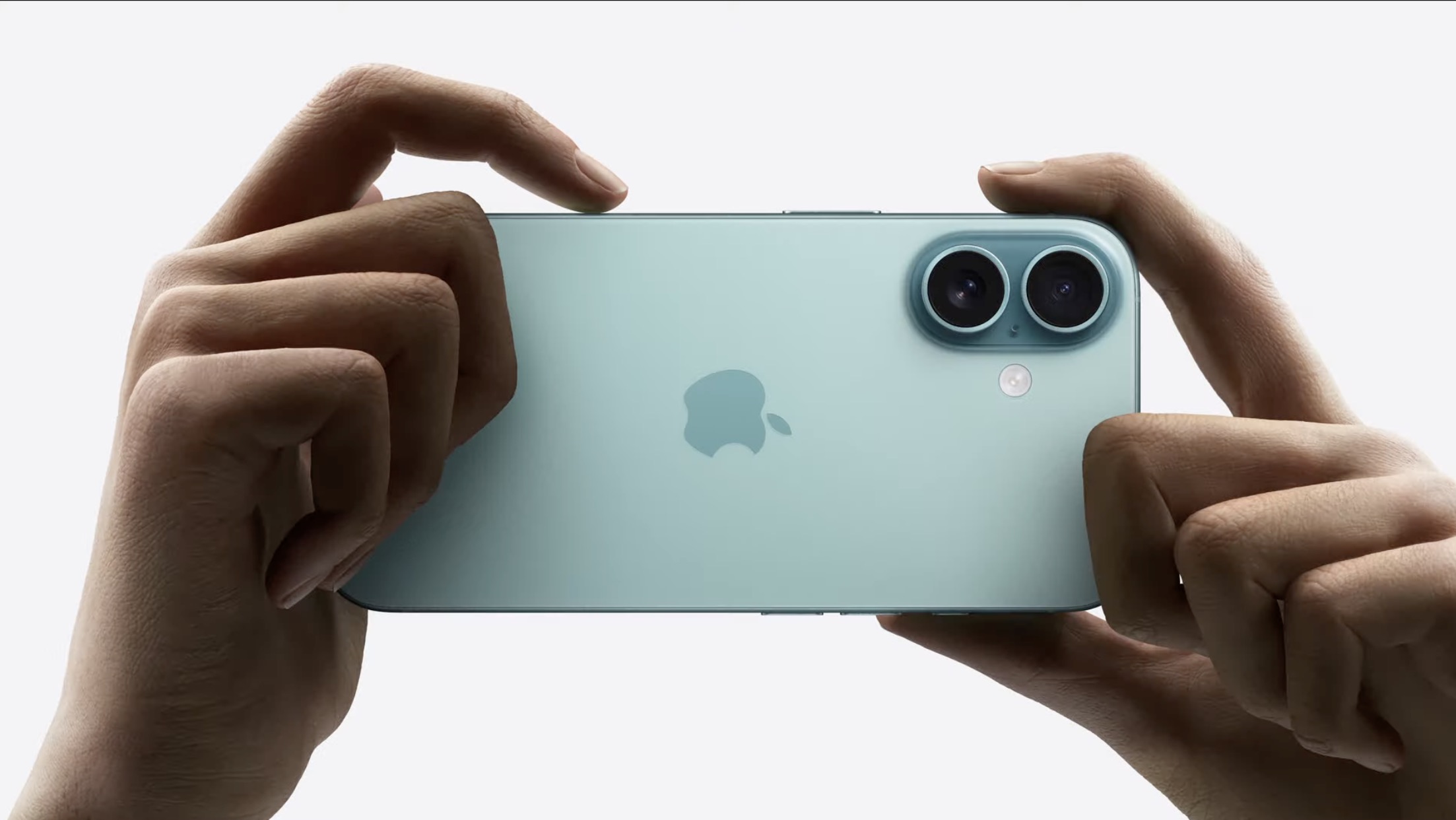
iPhone 16 gets a number of upgrades for shooting video. Those include macro video recording, spatial video recording, wind noise reduction, and audio zoom. Here’s the full rundown:
| iPhone 16 | iPhone 14 | iPhone 16 Plus | iPhone 14 Plus | |
| 4K Dolby Vision/HDR recording | ✅ – at 24, 25, 30, or 60 fps | ✅ – at 24, 25, 30, or 60 fps | ✅ – at 24, 25, 30, or 60 fps | ✅ – at 24, 25, 30, or 60 fps |
| 1080p recording | ✅ – at 25, 30, or 60 fps | ✅ – at 25, 30, or 60 fps | ✅ – at 25, 30, or 60 fps | ✅ – at 25, 30, or 60 fps |
| Cinematic mode | ✅ – up to 4K HDR at 30 fps | ✅ – up to 4K HDR at 30 fps | ✅ – up to 4K HDR at 30 fps | ✅ – up to 4K HDR at 30 fps |
| Action mode | ✅ – up to 2.8K at 60 fps | ✅ – up to 2.8K at 60 fps | ✅ – up to 2.8K at 60 fps | ✅ – up to 2.8K at 60 fps |
| ProRes recording | ❌ | ❌ | ❌ | ❌ |
| Log video recording | ❌ | ❌ | ❌ | ❌ |
| Macro video recording | ✅ | ❌ | ✅ | ❌ |
| Spatial video recording | ✅ – at 1080p at 30 fps | ❌ | ✅ – at 1080p at 30 fps | ❌ |
| Slo-mo recording | ✅ –1080p at 120 fps or 240 fps | ✅ –1080p at 120 fps or 240 fps | ✅ –1080p at 120 fps or 240 fps | ✅ –1080p at 120 fps or 240 fps |
| Time-lapse with stabilization | ✅ | ✅ | ✅ | ✅ |
| Night mode Time-lapse | ✅ | ✅ | ✅ | ✅ |
| QuickTake video | ✅ – up to 4K at 60 fps in Dolby Vision | ✅ – up to 4K at 60 fps in Dolby Vision | ✅ – up to 4K at 60 fps in Dolby Vision | ✅ – up to 4K at 60 fps in Dolby Vision |
| Stabilization | Sensor-shift optical image stabilization for video | Sensor-shift optical image stabilization for video | Sensor-shift optical image stabilization for video | Sensor-shift optical image stabilization for video |
| Cinematic video stabilization | ✅ – for 4K, 1080p, and 720p | ✅ – for 4K, 1080p, and 720p | ✅ – for 4K, 1080p, and 720p | ✅ – for 4K, 1080p, and 720p |
| Audio zoom | ✅ | ✅ | ✅ | ✅ |
| Stereo recording | ✅ | ✅ | ✅ | ✅ |
| True tone flash | ✅ | ✅ | ✅ | ✅ |
| Wind noise reduction | ✅ | ❌ | ✅ | ❌ |
| Audio Mix | ✅ | ❌ | ✅ | ❌ |
| Continuous autofocus video | ✅ | ✅ | ✅ | ✅ |
| Playback zoom | ✅ | ✅ | ✅ | ✅ |
Selfie camera
Apple’s TrueDepth front camera on the iPhone 16 and 16 Plus gets the latest gen Photographic Styles, Smart HDR 5 for photos, and support to record spatial audio.
| iPhone 16 | iPhone 14 | iPhone 16 Plus | iPhone 14 Plus | |
| TrueDepth front camera | 12MP, ƒ/1.9 aperture | 12MP, ƒ/1.9 aperture | 12MP, ƒ/1.9 aperture | 12MP, ƒ/1.9 aperture |
| Autofocus with Focus Pixels | ✅ | ✅ | ✅ | ✅ |
| Retina Flash | ✅ | ✅ | ✅ | ✅ |
| Photonic Engine | ✅ | ✅ | ✅ | ✅ |
| Deep Fusion | ✅ | ✅ | ✅ | ✅ |
| Smart HDR 5 for photos | ✅ | ❌ | ✅ | ❌ |
| Smart HDR 4 for photos | – | ✅ | – | ✅ |
| Next-gen portraits with Focus and Depth Control | ✅ | ❌ | ✅ | ❌ |
| Portrait Lighting with six effects | ✅ | ✅ | ✅ | ✅ |
| Animoji and Memoji | ✅ | ✅ | ✅ | ✅ |
| Night mode | ✅ | ✅ | ✅ | ✅ |
| Night mode time-lapse | ✅ | ✅ | ✅ | ✅ |
| Latest-gen Photographic Styles | ✅ | ❌ | ✅ | ❌ |
| Lens correction | ✅ | ✅ | ✅ | ✅ |
| Auto image stabilization | ✅ | ✅ | ✅ | ✅ |
| Wide color capture for photos and Live Photos | ✅ | ✅ | ✅ | ✅ |
| 4K Dolby Vision/HDR recording | ✅ – at 24, 25, 30, or 60 fps | ✅ – at 24, 25, 30, or 60 fps | ✅ – at 24, 25, 30, or 60 fps | ✅ – at 24, 25, 30, or 60 fps |
| 1080p recording | ✅ – at 25, 30, or 60 fps | ✅ – at 25, 30, or 60 fps | ✅ – at 25, 30, or 60 fps | ✅ – at 25, 30, or 60 fps |
| Cinematic mode | ✅ – up to 4K Dolby Vision HDR at 30 fps | ✅ – up to 4K HDR at 30 fps | ✅ – up to 4K Dolby Vision HDR at 30 fps | ✅ – up to 4K HDR at 30 fps |
| Apple ProRAW | ❌ | ❌ | ❌ | ❌ |
| ProRes recording | ❌ | ❌ | ❌ | ❌ |
| Log video recording | ❌ | ❌ | ❌ | ❌ |
| Slo-mo recording | ✅ –1080p at 120 fps | ✅ –1080p at 120 fps | ✅ –1080p at 120 fps | ✅ –1080p at 120 fps |
| QuickTake video | ✅ – up to 4K at 60 fps in Dolby Vision | ✅ | ✅ – up to 4K at 60 fps in Dolby Vision | ✅ |
| Cinematic video stabilization | ✅ – for 4K, 1080p, 720p | ✅ – for 4K, 1080p, 720p | ✅ – for 4K, 1080p, 720p | ✅ – for 4K, 1080p, 720p |
| Spatial Audio and stereo recording | ✅ | ❌ | ✅ | ❌ |
iPhone 16 vs 14 I/O
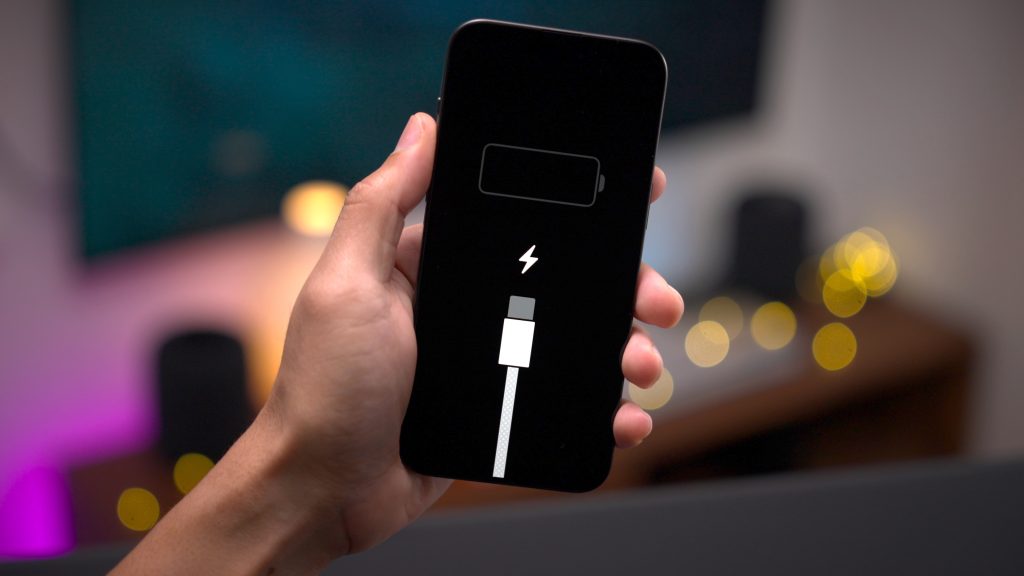
iPhone 16 devices use USB-C (USB 2) for the port while iPhone 14 uses Lightning. While they support the same top data transfer speed of 480Mbps, USB-C is more flexible and universal.
Other I/O updates are the new Camera Control button/sensor, WiFi 7, MagSafe supporting up to 25W or wireless power, Thread, and more.
| iPhone 16 | iPhone 14 | iPhone 16 Plus | iPhone 14 Plus | |
| USB-C | ✅ – USB 2 up to 480Mbps | ❌ | ✅ – USB 2 up to 480Mbps | ❌ |
| Lightning | – | ✅ – up to 480Mbps | – | ✅ – up to 480Mbps |
| WiFi | 7 | 6 | 7 | 6 |
| Bluetooth | 5.3 | 5.3 | 5.3 | 5.3 |
| UWB | ✅ – Gen 2 | ✅ – Gen 1 | ✅ – Gen 2 | ✅ – Gen 1 |
| NFC with reader mode | ✅ | ✅ | ✅ | ✅ |
| Thread | ✅ | ❌ | ✅ | ❌ |
| Cellular | GSM/EDGE, UMTS/HSPA+, DC-HSDPA | GSM/EDGE, UMTS/HSPA+, DC-HSDPA | GSM/EDGE, UMTS/HSPA+, DC-HSDPA | GSM/EDGE, UMTS/HSPA+, DC-HSDPA |
| 5G | Sub-6 GHz and mmWave with 4×4 MIMO | GSM/EDGE, UMTS/HSPA+, DC-HSDPA | Sub-6 GHz and mmWave with 4×4 MIMO | GSM/EDGE, UMTS/HSPA+, DC-HSDPA |
| 4G | Gigabit LTE with 4×4 MIMO and LAA | Gigabit LTE with 4×4 MIMO and LAA | Gigabit LTE with 4×4 MIMO and LAA | Gigabit LTE with 4×4 MIMO and LAA |
| GPS | GPS, GLONASS, Galileo, QZSS, and BeiDou | GPS, GLONASS, Galileo, QZSS, and BeiDou | GPS, GLONASS, Galileo, QZSS, and BeiDou | GPS, GLONASS, Galileo, QZSS, and BeiDou |
| Audio playback | Spatial audio/Dolby Atmos | Spatial audio/Dolby Atmos | Spatial audio/Dolby Atmos | Spatial audio/Dolby Atmos |
| Video playback | HDR with Dolby Vision, HDR10, and HLG | HDR with Dolby Vision, HDR10, and HLG | HDR with Dolby Vision, HDR10, and HLG | HDR with Dolby Vision, HDR10, and HLG |
| SIM | Dual eSIM in US | Dual eSIM in US | Dual eSIM in US | Dual eSIM in US |
| MagSafe | ✅ with 25W charging | ✅ with 15W charging | ✅ with 25W charging | ✅ with 15W charging |
| Qi and Qi2 | ✅ | ✅ | ✅ | ✅ |
iPhone 16 colors

iPhone 16 and 16 Plus come in these five colors:
- Black
- White
- Pink
- Teal
- Ultramarine
Storage and pricing
iPhone 16 and 16 Plus come in these storage options:
- 128GB – $799 / $899
- 256GB – $899 / $999
- 512GB – $1,099 / $1,199
What’s in the box?

All of the iPhone 16 devices just come with the iPhone and a USB-C cable in the box.
If you need a power adapter, go with at least a 20W so you get fast charging for your iPhone. Good options include:
- Anker 20W Nano Pro (super compact)
- Nomad 20W power adapter (black finish and compact)
- Apple’s official 20W adapter
iPhone 16 vs 14: Should you upgrade?
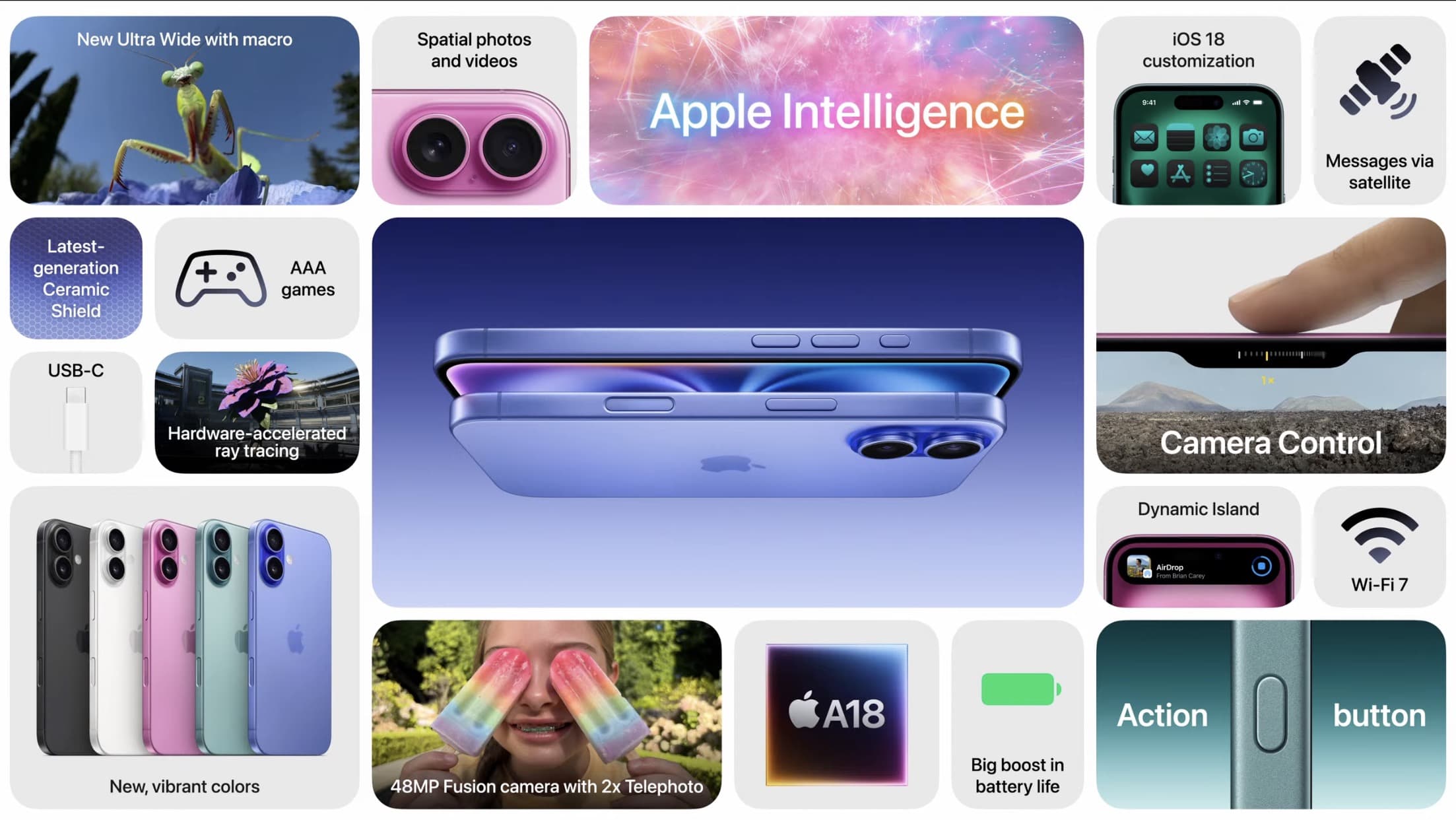
iPhone 16 and 16 Plus are powerful and capable devices, but which one is best for you or whether it’s time to upgrade will come down to how you want to use your iPhone and what features you value.
Reasons to buy iPhone 16 or 16 Plus
- Improved camera for photos and video
- Camera Control button/sensor + Action button
- Apple Intelligence support
- Faster A18 chip
- Hardware-accelerated ray tracing
- USB-C, WiFi 7, and 25W MagSafe charging, and Thread
Reasons to keep iPhone 14 or buy iPhone 15/Pro
- If the 6 features above aren’t a big deal, save your money and grab the iPhone 15 which includes most of the other features or keep your older iPhone 14 😁
- You could also consider grabbing an iPhone 15 Pro if you’d like Apple Intelligence support but don’t want/need the latest 16/16 Pro features
You can get iPhone 16 and 16 Plus from Apple, your carrier, and more.
What are you planning to do? Upgrade? Keep your current iPhone? Let us know in the comments!
Thanks for reading our guide on iPhone 16 vs 14!
FTC: We use income earning auto affiliate links. More.






Comments